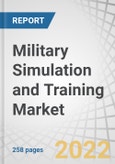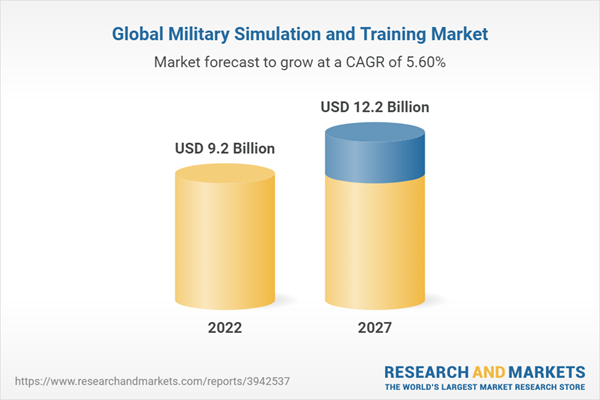The Military Simulation and Training market size is forecasted to grow from an estimated USD 9.2 billion in 2022 to reach USD 12.2 billion by 2027, at a CAGR of 5.6% from 2022 to 2027. Increasing defense spending in the world and new technological developments to help strengthen military capabilities and efficiency is expected to drive the market for Military Simulation and Training across the globe. Increasing geopolitical tensions across regions and overall strengthening activities across the world is triggering the defense spending across these regions. This, in turn, is pushing manufacturers and system component providers to design and manufacture more high technology, high resolution, military simulators for defense personnel to get trained upon.Acceptance of Virtual Pilot Training to Ensure Aviation Safety
The COVID-19 pandemic has caused significant damage to the economic activities of countries across the world. The manufacture of digital battlefield products, including systems, subsystems, and components, has also been impacted. Although military simulation and training products for defense applications are of prime importance, disruptions in the supply chain have halted their manufacturing processes for the time being. Resuming manufacturing activities depends on COVID-19 exposure, the level at which manufacturing operations are running, and import-export regulations, among other factors. While companies may still take orders, delivery schedules may not be fixed. Most key players in the Military Simulation and Training market like Lockheed Martin Corporation (US), Raytheon Technologies (US), and Rheinmetall AG(Germany) have declared that business has largely be returned to normal but acknowledged the impact of cost and schedules on most programs.
Based on platform, the land segment is expected to grow at the highest CAGR of 6.2% during the forecast period. The growth in demand for military vehicles across the land, sea, and aerial platforms would drive the market growth. Several countries are modernizing their military fleets by inducting newer generation vehicle platforms. This is generating a simultaneous demand for simulation-based training for the military personnel on these platforms, thereby propelling the market prospects of the related military simulators.
Based on Application, Aviation makes the largest share of the market during the forecasted year.
The aviation segment is expected to have a larger market share in the forecasted year. This is majorly due to the complexity and risk involved in aircraft compared to the other end users. For example, a single mistake by pilots on board a military aircraft while landing or take-off will cost the lives of people on board and result in the loss of sophisticated military property and compromise the mission. Such complexity has forced the military authorities to incorporate simulator-based training for pilots. Moreover, the increasing adoption of newer generation aircraft that incorporate complex technologies in the military may require training for pilots to familiarize themselves with the latest equipment and systems. In such situations, providing hands-on experience may be difficult due to high-cost involvement. In such cases, the simulators act as the preferred option
North America is projected to make the largest share of the market during the forecasted year.
The rising orders to replace the old navy fleet with new ones from the US and Canada and the rise in export of goods are the major factors driving the demand for new ship commanders and crew. This also leads to increased demand for military training systems. According to Boeing Technician Outlook 2019, North America is anticipated to require more than 193,000 aircraft technicians and maintenance crew between 2019 and 2038. This is anticipated to fuel the demand for maintenance crew training across the region during the forecast periodThis region is expected to lead the market from 2021 to 2026, owing to increased investments and the adoption of advanced military simulators for all the platforms by countries in this region.
The break-up of profile of primary participants in the Military Simulation and Training market:
- By Company Type: Tier 1 - 49%, Tier 2 - 37%, and Tier 3 - 14%
- By Designation: C Level - 55%, Director Level - 27%, and Others - 18%
- By Region: North America - 55%, Europe - 27%, Asia Pacific - 9%, RoW - 9%
Key Players:
Raytheon Technologies (US), Rheinmetall AG (Germany), BAE Systems (US), Lockheed Martin Corporation (US).
Research Coverage:
This research report categorizes the Military Simulation and Training Market by Type (Live, Virtual, Constructive), by application (Aviation, Army, Naval), by platform (Land, Airborne, Naval), by Technology (IoT, 5G, Cloud computing& master data management, Digital twin, robotic process automation, artificial intelligence, big data analytics, AR &VR), By environment (synthetic, gaming), by solution (hardware, software, upgrades, maintenance & support) in these segments have been mapped across major regions, namely, North America, Europe, Asia Pacific, Middle East and Rest of the world (Africa, Latin America). The scope of the report covers detailed information regarding the major factors, such as drivers, restraints, challenges, and opportunities, influencing the growth of the Military Simulation and Training market. A detailed analysis of the key industry players has been done to provide insights into their business overviews; solutions and services; key strategies; agreements, collaborations, new product launches, contracts, expansion, acquisitions, and partnerships associated with the Military Simulation and Training market.
Reasons to buy this report:
The report will help the market leaders/new entrants in this market with information on the closest approximations of the revenue numbers for the overall Military Simulation and Training and the subsegments. This report will help stakeholders understand the competitive landscape and gain more insights to position their businesses better and to plan suitable go-to-market strategies. The report also helps stakeholders understand the pulse of the market and provides them with information on key market drivers, restraints, challenges, and opportunities.
The report provides insights on the following pointers:
- Market Penetration: Comprehensive information on Military Simulation and Training offered by the top players in the market
- Product Development/Innovation: Detailed insights on upcoming technologies, research & development activities, and new product & service launches in the Military Simulation and Training market
- Market Development: Comprehensive information about lucrative markets - the report analyzes the Military Simulation and Training market across varied regions
- Market Diversification: Exhaustive information about new products & services, untapped geographies, recent developments, and investments in Military Simulation and Training market
- Competitive Assessment: In-depth assessment of market shares, growth strategies and service offerings of leading players in the Military Simulation and Training market
Table of Contents
1 Introduction
2 Research Methodology
4 Premium Insights
5 Market Overview
6 Industry Trends
7 Military Simulation and Training Market, By Application
8 Military Simulation and Training Market, By Training Type
9 Regional Analysis
10 Competitive Landscape
11 Company Profiles
List of Tables
List of Figures
Executive Summary
Companies Mentioned
- Avion Group
- Avt Simulation
- Bae Systems plc
- Bohemia Interactive Simulations
- Booz Allen Hamilton
- Cae Inc.
- Cubic Corporation
- Eca Group
- Elbit Systems Ltd
- Frasca International, Inc.
- Indra Sistemas Sa
- Inveris Training Solutions
- Kongsberg Maritime
- Leonardo Spa
- Lockheed Martin Corporation
- Northrop Grumman Corporation
- Precision Flight Controls, Inc.
- Raytheon Technologies
- Rheinmetall Ag
- Saab Ab
- St Engineering
- Textron
- Thales Sa
- The Boeing Company
- Virtra
- Vstep Bv
Methodology

LOADING...
Table Information
| Report Attribute | Details |
|---|---|
| No. of Pages | 258 |
| Published | April 2022 |
| Forecast Period | 2022 - 2027 |
| Estimated Market Value ( USD | $ 9.2 Billion |
| Forecasted Market Value ( USD | $ 12.2 Billion |
| Compound Annual Growth Rate | 5.6% |
| Regions Covered | Global |
| No. of Companies Mentioned | 26 |









